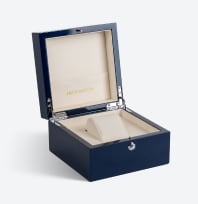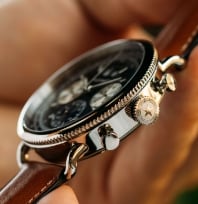Watches are incredible devices. They’re the perfect blend of fashion and function—providing a stylish accessory to any outfit while also allowing their wearers to tell the time with a subtle glance at their wrists.
That’s why it can be frustrating to pick up one of your favorite timepieces only to see that its hands have stopped turning. In order to accurately tell the time, you now need to reset the watch to the correct time and wind it so that it maintains enough power to keep running.
While this isn’t necessarily the most labor-intensive of tasks, it can take time out of your day. Luckily, there are devices on the market that allow you to set your watch down and not worry about having to rewind it when you pick it back up. These devices are called automatic watch winders, and they can be a valuable addition to any watch enthusiast’s collection.
How do automatic watch winders work, and do you really need one? While we won’t tell you what you do and don’t need to (that’s up to you), we’re here to tell you how these devices work—but first, let’s talk about the devices that they maintain: watches.
Mechanical Watches
The first watches were purely mechanical. With a complex series of simple (and tiny) machines, watch movements were composed of many moving parts that worked together to keep time. These early watches weren’t incredibly accurate, but they were more convenient than searching for a clock tower or asking a stranger to check the clocks in their home. These were the days before wristwatches, when the pocket watch was the only portable timepiece available.
Over the course of centuries, timepieces were engineered to be more accurate, but they were still completely mechanical—and these miniature mechanical marvels were made possible by the invention of one component: the mainspring.
The Mainspring
The mainspring is a tightly-wound, ultra-thin strip of metal that provides all of the power for a mechanical watch (you can think of it as the watch’s engine). The mainspring operates inside with the help of the mainspring barrel—a tiny canister that keeps the mainspring tightly wound and prevents it from releasing tension all at once.
The mainspring is connected to the crown of the watch. The crown is the knob that you use to wind your watch (or to move the watch’s hands). With a mechanical watch, when you twist the crown, it, in turn, increases the tension of the mainspring.
While the mainspring barrel keeps the mainspring from unwinding all at once, it does allow tiny amounts of tension to be released gradually. As tension is released, the mainspring provides power to the various wheels inside the watch. Some of these wheels are attached to the watch’s hands—as they turn, so do the hands.
A collection of parts know as the escapement controls the gradual release of the mainspring’s power. The escapement is composed of the pallet fork and the escape wheel.
The Pallet Fork and Escape Wheel
The pallet fork and escape wheel work in tandem to allow power to flow from the mainspring in tiny, measured increments. As power is released, the pallet fork ticks back and forth, locking into an escape wheel tooth with each swing. As the pallet fork slips free, the escape wheel moves forward ever so slightly. As the escape wheel turns, so do the other wheels of the watch.
As long as there is mainspring power in the watch, this process keeps repeating.
Have you heard that it’s impossible to improve upon the wheel? Well, it’s pretty hard to improve on the watch, too! It’s endlessly fascinating that such simple machines from long ago are still the basis upon which we craft the modern watch.
The One Problem With Mechanical Watches
Mechanical watches are undeniably incredible, but they come with limitations. Because they’re purely mechanical, these watches need to be wound frequently to maintain accuracy. If you don’t wind your mechanical watch, the mainspring will gradually run out of power, and the watch will slow and eventually stop. Of course, once you rewind your watch, power will return to the mainspring, and the watch will start working again.
But what if you don’t want to have to wind your watch constantly? This was the question that led watchmakers to invent other types of watch movement: quartz and automatic.
-
Quartz – the most modern type of watch movement, quartz movements rely on a battery rather than a mainspring to power the watch. Because of this, these watches are often much simpler than mechanical watches—they don’t need as many moving parts because so many of the watch components’ tasks only rely on a single battery. With a quartz watch, you don’t need to wind the watch at all—the battery keeps it running.
- Automatic – very similar to mechanical watches in almost every way, automatic watches have many of the same components as mechanical watches. However, the big difference is in the watch’s ability to wind itself as its wearer moves.
How Do Automatic Watches Work?
Similar to a mechanical watch, automatic watches rely on a mainspring to power the watch’s other components. The tightly wound mainspring gradually releases power through the escapement, and the watch’s wheels move in turn.
But instead of relying on the wearer of the watch to wind the mainspring using the crown, automatic watches have a specially designed rotor system that’s attached to the mainspring. As you walk, you swing your arms; as you swing your arms, the rotor inside the automatic watch spins around—winding the mainspring and providing power to the watch’s movement.
Why Do You Need An Automatic Watch Winder?
At this point, you may find yourself asking, “if automatic watches wind themselves…why would I need an automatic watch winder?”
That’s a good question, and the answer comes down to how often you wear your automatic watch. If you wear it all the time, every single day, you may not need a winder. But suppose you occasionally take off your automatic watch and set it down, whether to switch to a different watch in your collection or to go watch-free for a couple of days (we don’t know how anybody can do that but to each their own)? In that case, you might find yourself with a problem.
Because automatic watches rely on your movement to wind themselves, they’re not quite self-winding—they still need you to wind the mainspring, even if they’re depending on your movement instead of your taking the time to twist the watch’s crown. A person’s natural movement in their day-to-day life can create enough spin in an automatic watch’s rotor to keep a watch running for around 35 to 45 hours.
So, if you leave your automatic watch on the shelf for a few days, you’ll have to wind it again to get enough power in the mainspring to make the watch work again.
Whether you have a mechanical watch or an automatic watch, it needs to be wound from time to time—and if you have multiple watches in your collection, it can be very tedious to have to constantly wind your timepieces by hand.
That’s where the watch winder comes in.
How Does A Watch Winder Work?
Watch winders work by slowly rotating your automatic watch on a sideways turntable within a specialized case or device, eliminating the need to wind the watch by hand. As the winder rotates, the rotor inside the watch spins, slowly winding the mainspring.
Watch winders come in many different sizes. Some of the simpler models hold and wind one watch at a time. These single-watch winders can be a good option for beginner collectors who want to delve into the world of automatic watch winders.
For watch collectors with multiple automatic watches that they want to keep wound at all times, there are automatic watch winders that can hold several watches at once and keep each one spinning on an individual turntable. These cost substantially more than the simple single-watch winders, but they’re very handy for the experienced collector who doesn’t want to wind the mainspring and set the time whenever they put on a different watch.
While these watch winders aren’t necessary, they can make for highly useful tools in a watch enthusiast’s arsenal.
Winding Down
Whether you’re a beginner watch collector or a longtime enthusiast, there are definite benefits to owning an automatic watch winder. It’s not necessary, but watch winders aren’t about necessity—they’re about improving quality of life. If you find yourself frustrated in the tedium of constantly winding your watches and resetting the time, an automatic watch winder might be the perfect solution to your problem.
Of course, if you enjoy the ritual of winding a watch by hand, that’s understandable—while watches are stylish accessories, they’re also tactile ones. It can be satisfying to take a moment to reacquaint yourself with your treasured timepiece, knowing that every twist of its crown is providing its mainspring with the power to get you through another day.
Sources:
6 Simple Machines: Making Work Easier | Live Science
History of Pocket Watches - Invention of Pocket Watch | History of Watch
What Is a Watch Mainspring and How Does It Work? | Bloomberg












